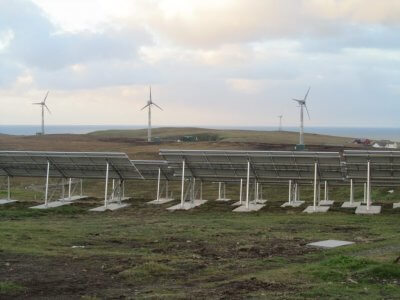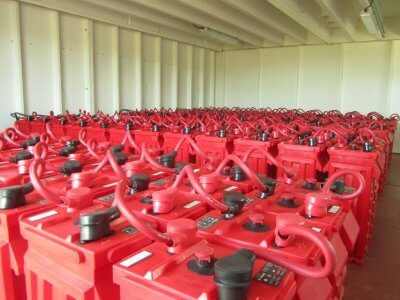By Dr. Alistair Davidson, Director, CBI
As the demand for reliable energy storage continues to soar, it is matched by pressure to develop more innovative, higher performing batteries. With a global shift to cleaner, renewable sources of energy, such as wind and solar power, power grids are increasingly relying on batteries to provide vital functions such as frequency regulation, peak shaving and load following.

The Fair Isle energy storage system has a power output of 126 kW with 588 kWh of storage energy available.
The vast increase in demand for energy storage presents a real opportunity for all battery technologies to play their part in widespread electrification. Many battery chemistries operate in the energy storage sector to provide these vital functions, all offering different attributes for the diverse applications existing in this market. However, the demands of these applications are constantly evolving, and it is vital that all battery chemistries can adapt and improve to meet the challenging technical requirements in this field.
Advanced lead batteries currently represent more than 70% of the rechargeable battery market driven by the fact that virtually every vehicle on the road utilizes a lead battery. From providing SLI (safety, lighting, ignition) capability in conventional cars, to start-stop functionality in micro and mild hybrid vehicles, to powering essential safety features and battery management systems in electric vehicles, lead batteries have demonstrated they have excellent performance combined with unmatched reliability, safety and affordability.
Lead batteries are also the dominant technology in applications such as UPS, backup for telecoms and datacenters, and are increasingly being utilized by energy storage installations. From large-scale grid stabilizing applications, to mid-scale industrial projects for demand response, to small-scale microgrids, the safety, sustainability and reliability of advanced lead batteries enable them to be a utilized across the diverse needs of the energy storage sector.
2019 saw the Consortium for Battery Innovation (CBI), the world’s only pre-competitive research hub dedicated to innovation in lead battery technology, unveil a new technical roadmap. It is trailblazing innovative research projects dedicated to improving lead battery performance for different applications in a range of key markets.

The system on Fair Isle comprises seven strings of 48 Rolls batteries, three 60-kW wind turbines and 52 kW of PV panels connected to three 15-kW inverters.
The lead battery sector’s close relationships with end-users such as utility and renewable energy companies, together with in-depth market analysis, have driven performance priorities. The roadmap identifies improved performance in the short term to include increasing lead battery cycle life by five times by 2021 to 5,000 cycles, a highest priority. The intermittent nature of renewable energy sources means achieving this key technical requirement will facilitate the increased use of advanced lead batteries that can provide reliable service at partial state-of-charge.
Supporting this shift to an energy storage focus, CBI launched an interactive map featuring global examples of lead batteries in action for energy storage installations. From the highest solar farm in the world in Tibet to remote communities using wind power on islands, lead batteries are supporting the global renewable energy transition.
Located in the far-flung islands of Scotland, communities have received access to 24-hour, reliable power for the first time, supported by a combination of wind energy and advanced lead battery backup, from Fair Isle to the Isle of Muck. Across the equator in Madagascar’s community of Satrokala, wind energy is being harnessed and supported by lead batteries to deliver more than 20,000 liters of freshwater every day to a population of 1,500 people.
Our industry is still in the early days of deployment in energy storage systems, but our interactive map and technical case studies highlight the growing role lead battery technology is playing. With an end-of-life recycling rate of 99%, cost-effectiveness and the ability of many advanced lead batteries to achieve 4,000-5,000 deep-cycles, lead batteries will be one of the key battery contenders in energy storage systems of the future.
This year, as the global industry we serve recognizes the growing importance and demand for energy storage, CBI has launched a new research bid focusing on innovation in lead battery technology for these applications.
This is driven by the fact that our technology still has significant untapped potential for innovation that our new request for proposals aims to explore. CBI has identified that deeper insight into operational regimes for lead batteries in energy storage systems applications is needed both in the field and laboratory tests. This will provide deeper insights into total energy throughput and increasing cycle life.
As societies and nations across the globe continue on the transition to a cleaner, more sustainable society, energy storage is a cornerstone to achieving this. Battery technologies that can support this transition will be in demand across diverse energy storage systems, and advanced lead batteries are continuing in their innovation journey to fulfill this demand.
Filed Under: Featured




